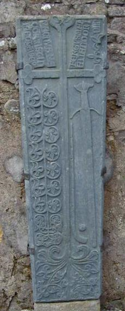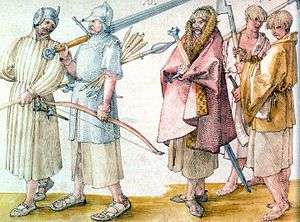Gallowglass
The gallowglasses (also spelled galloglass, gallowglas or galloglas; from Irish: gall óglaigh meaning foreign warriors) were a class of elite mercenary warriors who were principally members of the Norse-Gaelic clans of Scotland between the mid 13th century and late 16th century. As Scots, they were Gaels and shared a common background and language with the Irish, but as they were descendants of 10th century Norse settlers who had intermarried with the local population in western Scotland, the Irish called them Gall Gaeil ("foreign Gaels").
Large numbers of gallowglass septs settled in Ireland after being dispossessed of their lands in Scotland for choosing to fight on the side for independence from England in the Wars of Scottish Independence. An early family of gallowglasses were the MacSweeneys, settled by the O'Donnells in north Donegal. These were followed by MacDonnells, MacCabes and several other groups settled by powerful Irish nobles in different areas. The gallowglasses were attractive as a heavily armoured, trained aristocratic infantry to be relied upon as a strong defence for holding a position, unlike most Irish foot soldiers, who were lower class and less well armoured than the typical Irish noble who fought as cavalry. In time there came to be many native Irish gallowglasses as the term came to mean a type of warrior rather than an ethnic designation.
They were a significant part of Irish infantry before the advent of gunpowder, and depended upon seasonal service with Irish chieftains. A military leader would often choose a gallowglass to serve as his personal aide and bodyguard because, as a foreigner, the gallowglass would be less subject to local feuds and influences.
Name
The term is an anglicisation of the Irish gallóglaigh (lit. "foreign young warriors"), with the English plural -s added to the end. The singular of gallóglaigh is gallóglach. The word óglach comes from Old Irish oac (meaning "youth") and Old Irish lóeg (meaning "calf" but later becoming a word for a hero). Although the English term comes from an Irish plural, Encarta specifies the plural of gallowglass to be "gallowglasses". Shakespeare uses the form "gallowglasses" in the play Macbeth.
The Oxford English Dictionary prefers the spelling "galloglass" and provides several examples attesting to ordinary English plural forms of the word, dating back to a c. 1515 use of "galloglasseis". "The etymologically correct form galloglagh appears later than the erroneous galloglass, which was probably the result of the plural gallogla(gh)s; in some early instances galloglas seems to be used as a plural, but galloglasses is found already in our earliest quot."[1]
Origin
The gallowglass were from the western coast of Scotland, principally Argyll and the Western Isles.[2] Their weapon of choice was a battle axe, but claymores were not uncommon. Each was usually accompanied by a man to see to his weapons and armour and a boy to carry provisions.
Description
A description from 1600, speaks of the Gallowglass as "...pycked and scelected men of great and mightie bodies, crewell without compassion. The greatest force of the battell consisteth in them, chosing rather to dye than to yeelde, so that when yt cometh to handy blowes they are quickly slayne or win the fielde."[3]
History

The first record of gallowglass service was in 1259, when Aedh Ó Conchobair, King of Connacht, received a dowry of 160 Scottish warriors from the daughter of Dubhghall mac Ruaidhri, the King of the Hebrides. They were organised into groups known as a "Corrughadh", which consisted of about 100 men.
The importation of gallowglasses into Ireland was a major factor in containing the Anglo-Norman invasion of the 12th century, as their ranks stiffened the resistance of the Irish lordships. Throughout the Middle Ages in Ireland, gallowglass troops were maintained by Gaelic Irish and Hiberno-Norman lords alike. Even the English Lord Deputy of Ireland usually kept a company of them in his service. (See also: Norman Ireland.)
In return for military service, gallowglass contingents were given land and settled in Irish lordships, where they were entitled to receive supplies from the local population.
By 1512, there were reported to be fifty-nine groups throughout the country under the control of the Irish nobility. Though initially they were mercenaries, over time they settled and their ranks became filled with both Scots-Norse and many native Irish men.
In 1569, Turlough Luineach O'Neill (The O'Neill) married Lady Agnes Campbell, daughter of Colin Campbell, 3rd Earl of Argyll, and widow of James MacDonald, 6th of Dunnyveg. Her dowry consisted of at least 1,200 gallowglass fighters. Along with two young men as support and friends on top to assist or fight this could easily have numbered over 5,000 current and future gallowglasses coming into the area.[4]
They were noted for wielding the massive two-handed sparth axe (a custom noted by Geraldus Cambrensis, died c. 1223, to have derived from their Norse heritage) and broadsword or claymore ("claidheamh mór"). For armour, the gallowglass wore a mail shirt over a padded jacket and an iron helmet; he was usually accompanied by two boys (like a knight's squires), one of whom carried his throwing spears while the other carried his provisions.
Shakespeare mentions gallowglasses in his play Macbeth, although along with other aspects of the play it is an anachronism, as the historical Macbeth lived in the 11th century:
The merciless Macdonwald,
Worthy to be a rebel, for to that
The multiplying villainies of nature
Do swarm upon him, from the Western isles
Of kerns and gallowglasses is supplied
In a paper entitled "A Description of the Power of Irishmen", written early in the 16th century, the Irish forces of Leinster are numbered at 522 horse, five battalions of gallowglass (gallóglaigh) and 1,432 kerne, and those of the other provinces were in like proportion. Mac Cárthaigh Mór commanded 40 horse, two battalions of gallowglass, and 2,000 kerne; the Earl of Desmond 400 horse, three battalions of gallowglass, and 3,000 kerne, besides a battalion of crossbowmen and gunners, the smaller chieftains supplying each their quota of men.

In 1517, "when the reformacion of the countrye was taken in hand", it was reported that the Irish forces in Thomond were 750 horse, 2,324 kerne, and six "batayles" of gallowglass, the latter including 60 to 80 footmen harnessed with spears; each of these had a man to bear his harness, some of whom themselves carried spears or bows.
Every kerne had a bow, a "skieve" or quiver, three spears, a sword, and a skene[5] (Irish scian or Scottish Gaelic sgian), each two of them having a lad to carry their weapons. The horsemen had two horses apiece, some three, the second bearing the "knave" or his attendant.
The 16th century in Ireland saw an escalation in military conflict, caused by the Tudor conquest of Ireland. Gallowglass fighters were joined by native Irish mercenaries called buanadha (literally "quartered men") and by newer Scottish mercenaries known as "redshanks". The flow of mercenaries into Ireland was such a threat to English occupation that Queen Elizabeth I took steps against them in 1571—around 700 of them were executed after the first of the Desmond Rebellions.
Despite the increased use of firearms in Irish warfare, gallowglasses remained an important part of Hugh Ó Neill's forces in the Nine Years War. After the combined Irish defeat at the Battle of Kinsale in 1601, recruitment of gallowglasses waned, although Scottish Highland mercenaries continued to come to Ireland until the 1640s (notably Alasdair Mac Colla). They fought under the Irish general Eoin Roe O'Neill at the Battle of Benburb when O'Neill had an overwhelming victory in 1646. The gallowglasses of the Mac Cárthaigh Riabhaigh are recorded as having attacked Mallow in County Cork as late as 1645.
Images of gallowglasses fighting as mercenaries in European mainland armies were sketched by Dürer in 1521 and later by French and Dutch artists[6]. Gallowglasses served in the Dutch Blue Guards, Swiss Guard, the French Scottish Guard, and the forces of King Gustavus Adolphus of Sweden in his invasion of Livonia during the Thirty Years' War.
Milford or Millford, historically called Ballynagalloglagh (from Irish: Baile na nGallóglach), is a small town and townland in County Donegal, Ireland. The Irish Baile na nGallóglach literally means "town of the gallóglach". A battle between the Irish (helped by gallóglaigh) and the English took place on a hill in the townland and this is where the name comes from.
References
- "galloglass". Oxford English Dictionary.
- Cannan, Fergus. Gallowglass 1250–1600, Osprey Publishing, 2010, ISBN 9781846035777.
- Tracts relating to Ireland, Irish Archeological Society, vol. ii., Dublin, 1843
- "Gallowglass children in battle".
- Sgian-dubh
- 1931–1996., Somerset Fry, Plantagenet (1991). A history of Ireland. Somerset Fry, Fiona. London: Routledge. ISBN 0415048885. OCLC 22907123.CS1 maint: numeric names: authors list (link)
Sources
- G. A. Hayes McCoy, Irish Battles, Appletree Press, Belfast, 1990.
- Colm Lennon, Sixteenth Century Ireland: The Incomplete Conquest, Gill & MacMillan, Dublin 1994.
- The Galloglass Project (compiled at TCD, placed online at UCC)